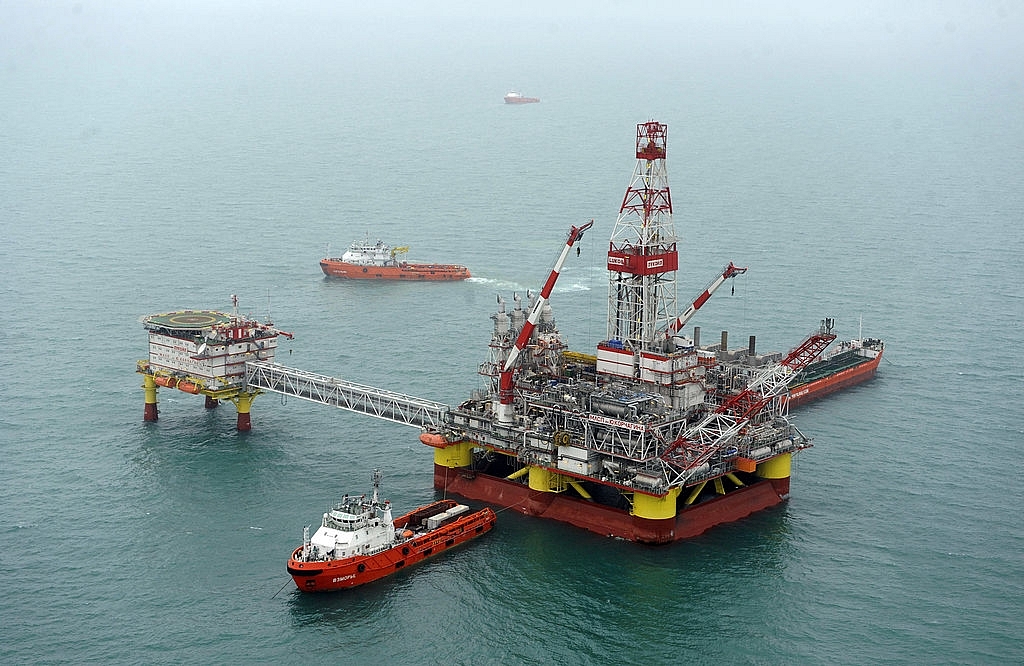Economy
Deepavali Cheer For ONGC, But What About The Oil Marketing Companies?
- In contrast to the stellar show by ONGC, oil marketing companies have reported a rather lacklustre performance in the September 2018 quarter.

An ONGC oilfield. (MIKHAIL MORDASOV/AFP/GettyImages)
Global crude oil prices, like Brent, had surged to $85 per barrel levels in late September/early October 2018 from $70 per barrel levels six weeks earlier, given the global tensions relating to US sanctions on Iranian crude oil exports. While the broader Indian economy has been grappling with weakening macro-economic indicators and a depreciating rupee over the past few months, a key beneficiary of rising crude oil prices is the upstream oil and gas player, Oil and Natural Gas Corporation (ONGC). An upstream player refers to searching and production of oil and gas.
It was no surprise that ONGC on Saturday announced a 47.6 per cent year-on-year (y-o-y) increase in its revenue from operations to Rs 27,989.2 crore in the September 2018 quarter, while its net profit jumped 61 per cent y-o-y to Rs 8,264.6 crore. The company in the September 2018 quarter has benefited from strong oil prices coupled with a weak rupee, with its crude oil price realisations jumping more than 60 per cent per barrel on a y-o-y basis. However, the company’s total crude oil production declined 5.8 per cent y-o-y to 6.07 million tonnes in the quarter under review.
Domestic production of crude oil is barely able to meet 20 per cent of the country’s annual requirement, point out analysts tracking this sector. Rapid urbanisation along with growth in two-and-four wheeler vehicle sales has made India one of the fastest growing oil consuming markets globally, and one of the largest importers of crude oil.
According to data obtained online, India imported nearly 220 million tonnes of crude oil for the financial year which ended in March 2018, a rise of about 3 per cent y-o-y.
Impact On The Local Economy
The recent surge in global crude oil prices resulted in retail petrol prices shooting up to between Rs 82-87 per litre levels in September/early October, depending on the city and local state government taxes. Consumers were certainly not very happy.
Rising global crude oil prices had led to the total oil import bill of the country jumping 50 per cent y-o-y to $69.7 billion during April until September of the current financial year, according to data sourced from the Union Commerce Ministry.
Taking into account the country’s merchandise and services exports and imports, the trade deficit jumped 30 per cent y-o-y to $56 billion during the first half of the current financial year. The impact of the unfavourable macro-environment was clearly visible with the rupee dropping to a record low of Rs 74 levels vis-a-vis the dollar in early October.
In contrast to the stellar performance of ONGC, oil marketing companies have reported a rather lacklustre performance in the September 2018 quarter. Oil marketing companies import crude oil from the Middle-East, refine it and sell products like petrol and diesel to consumers across the country via their dealer network.
For instance, in the case of Bharat Petroleum Corporation, it reported a near 48.3 per cent y-o-y fall in its net profit to Rs 1,218.7 crore in the September 2018 quarter, and that’s despite a 29.2 per cent rise in net sales to Rs 82,884.8 crore. The company has highlighted that its average gross refining margin was $5.57 in the September 2018 quarter vis-a-vis $7.97 per barrel a year earlier.
Gross refining margin broadly refers to the difference between the price of crude oil imported per barrel and the selling price of refined products like aviation fuel, amongst others.
Similarly, Hindustan Petroleum Corporation had reported a 37 per cent y-o-y fall in its net profit to Rs 1,092 crore in the September 2018 quarter and that’s despite total revenues from operations rising 35 per cent to Rs 73,376 crore. This player, too, had to face lower gross refining margins.
Rays Of Hope
Global crude oil prices like Brent have cooled off and are currently at $72-73 per barrel levels with global media reports indicating that US has granted sanction waivers to countries like India, Japan and South Korea for their crude oil imports from Iran. While upstream players like ONGC could see a fall in their realisations compared to the levels realised in the September 2018 quarter, but the country’s macro-economic indicators have shown an improvement. The rupee has strengthened and is currently at Rs 72.5 levels per dollar, and if the current trend in oil prices continues, the oil import bill should also drop, going forward.
Support Swarajya's 50 Ground Reports Project & Sponsor A Story
Every general election Swarajya does a 50 ground reports project.
Aimed only at serious readers and those who appreciate the nuances of political undercurrents, the project provides a sense of India's electoral landscape. As you know, these reports are produced after considerable investment of travel, time and effort on the ground.
This time too we've kicked off the project in style and have covered over 30 constituencies already. If you're someone who appreciates such work and have enjoyed our coverage please consider sponsoring a ground report for just Rs 2999 to Rs 19,999 - it goes a long way in helping us produce more quality reportage.
You can also back this project by becoming a subscriber for as little as Rs 999 - so do click on this links and choose a plan that suits you and back us.
Click below to contribute.
Latest